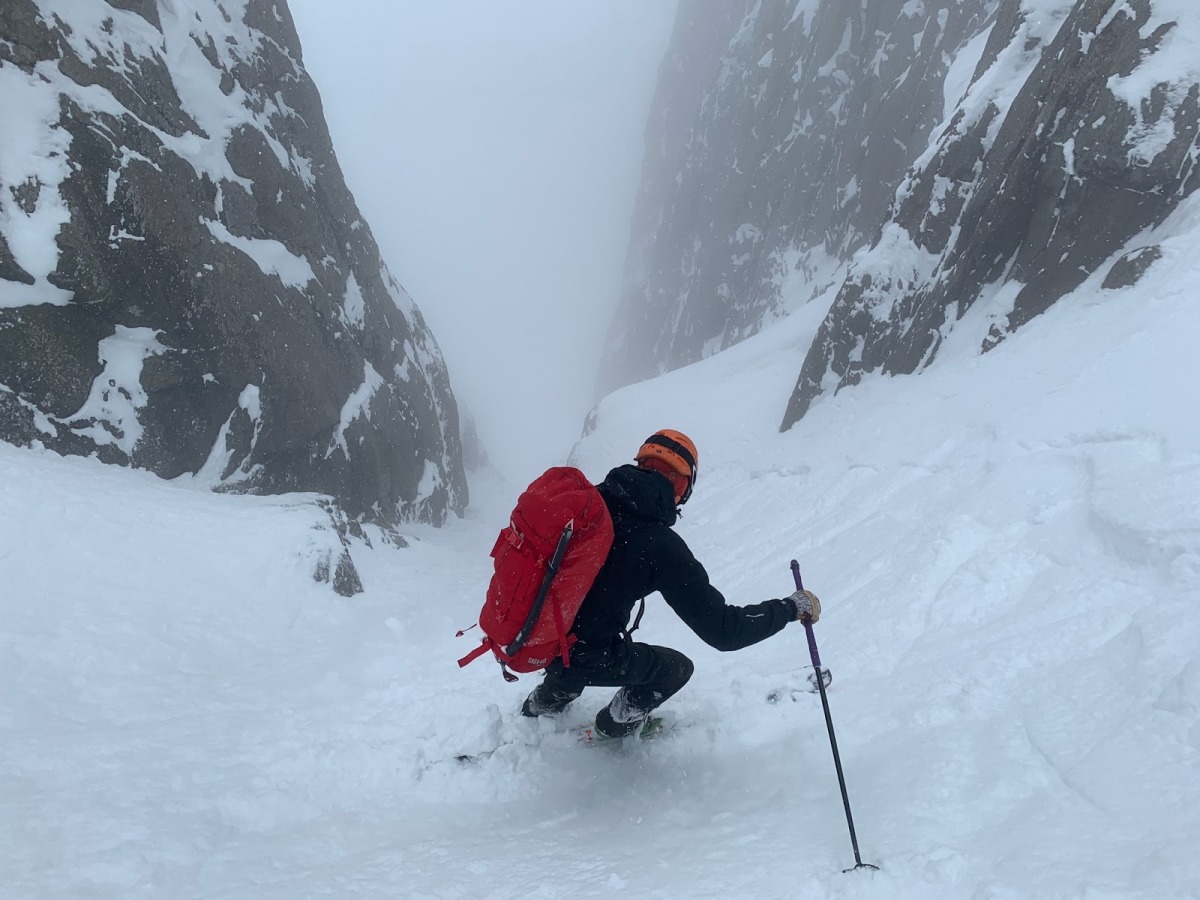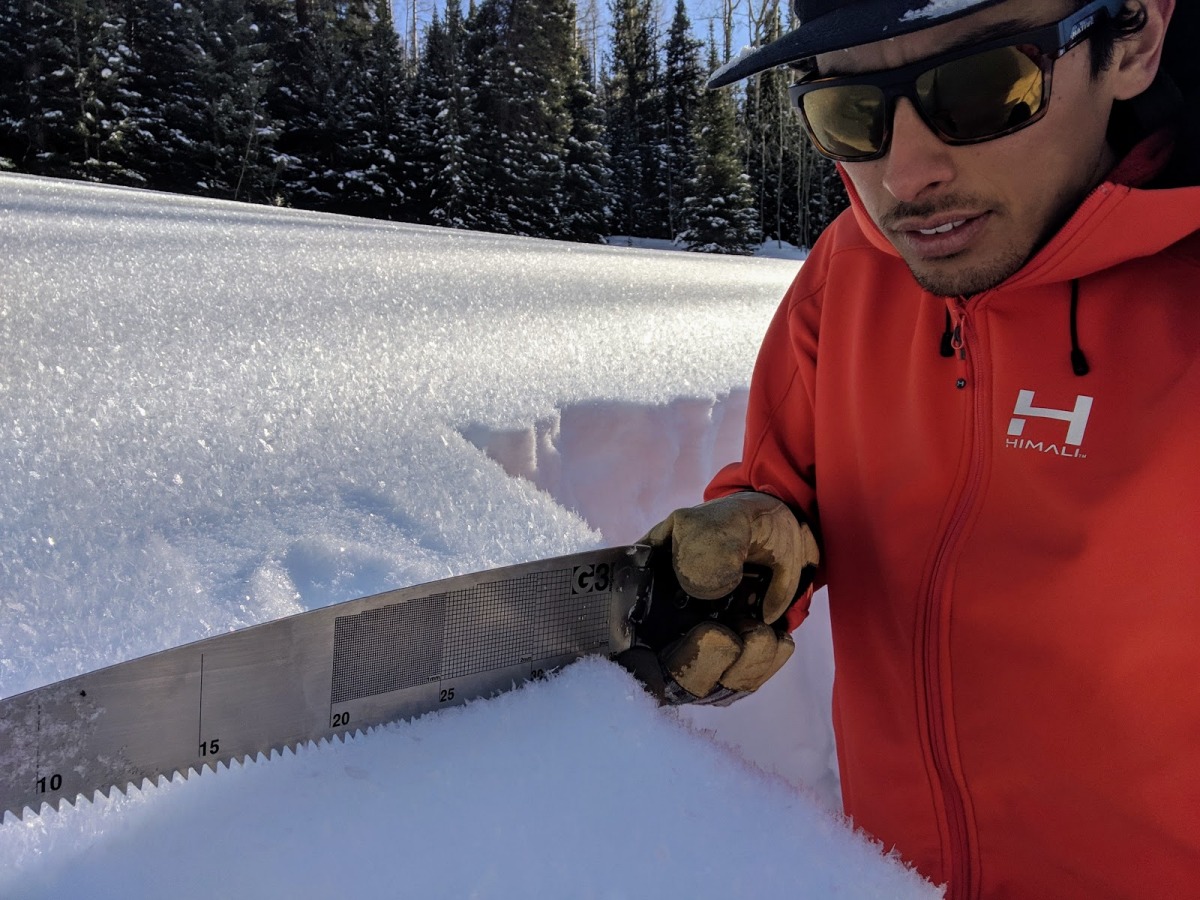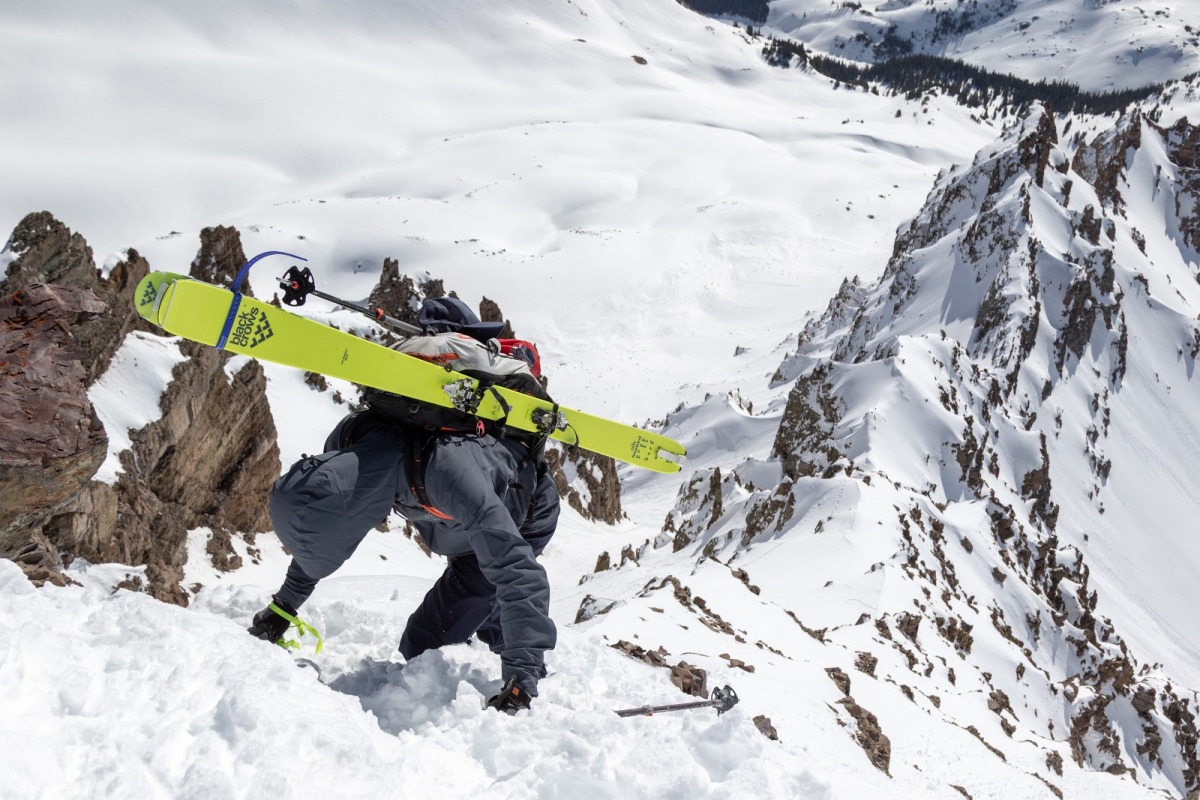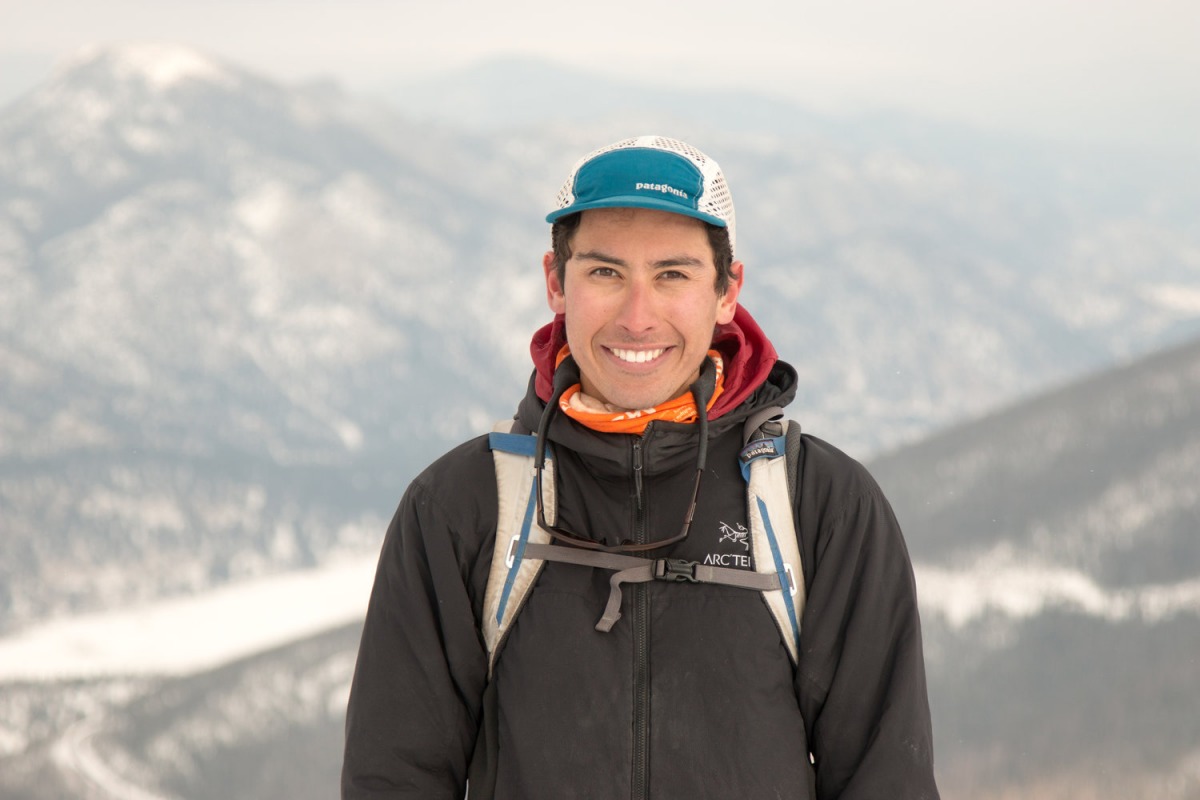
The author backcountry skiing on the traditional Indigenous land of the Núu–agha–tuvu–pu (Ute) and Pueblo tribes that still exist today. (Photo: Kyle Ramer)
I’ll never forget the day I was finally invited on a ski trip. I was fourteen, living in Denver and for years I had been trying to build friendships based on a shared love of skiing. That day, my newfound friends were attempting to ski the east wall at A-Basin. Out of the group, I was the only one to ski the steep chute cleanly. From the bottom, I overheard my friends say to each other with surprise, “Wow, Browntown sent that.”
Browntown was not a nickname they called me to my face.
It’s not a secret that our sport of backcountry skiing is as white as the snow we slide on. To establish this baseline we don’t have to look further than the voices that shape our community. Ski magazines feature predominantly white athletes, film reels highlight white experiences in the mountains, and avalanche education and outreach are facilitated by a predominantly white community. If recent public support for the work towards justice and equity for Black America affects backcountry skiing in any way, it needs to force us to really look introspectively at our implicit biases, racism, and the ski culture built around white elitism that led us here.
I want to get a few acknowledgments out of the way. There is no question that I am writing this article from a place of privilege. As you’re reading, I am guessing that you are thinking to yourself “what does a guy with the name ‘Aidan Goldie’ have to say about race?” While many aspects of my outward appearance are white — my name, my lack of foreign accent, my cultural experiences living in a white-dominated space — I am writing in order to provide a single perspective of the experience of an immigrant with brown skin, fully acknowledging that this experience is not representative of all people of color. That being said, I don’t need the qualifier of being a person of color to open up this conversation. This is one that we should have started a long time ago.
I was born in Chile to a Canadian father and Chilean mother where much of my childhood was spent living in South America. Even before living in a place with close access to snowy mountains, I inherited a love for skiing from my father who grew up skiing in eastern Canada. If you are familiar with the breed of skier that the east coast will produce, you’ll find nobody more excited about a 200m icy run on their local mountain. Despite our family living in tropical mountain forests without any snow, I daydreamed about one day climbing and skiing bigger mountains and I cherished the few opportunities I had to be introduced to skiing during my childhood.
Our family immigrated to Colorado when I was 12 years old, and my first Christmas I was met with a pair of yellow Solomon skis under our tree. Suddenly the scale of our skiing trips increased. Our first winter in Colorado my dad made it a point to brave the I-70 traffic on most weekends and venture out to the mountains and instill in me a love for skiing that he himself had grown up with. At the same time, I would become very aware that I was the only brown face amid lift lines and I realized how rare it was for people like me to occupy this space.
Barriers to entry
There are countless barriers to entry when it comes to skiing, let alone backcountry skiing, and they disproportionately affect people of color. The basic idea of voluntarily spending your free time in the cold outdoors is rooted in privilege. We make a voluntary choice to suffer for recreation. But really the first barrier to entry is geographic. This doesn’t just mean those that live in warmer states without the necessary snowpack, but even those that live in urban centers like Denver with larger populations of marginalized communities of color where a journey to the mountains represents a significant investment of both time and money.
For those that make it to the base of the mountain, many other barriers await. First is the gear. Even at entry-level costs, ski gear is an investment that may not be fulfilled. This is not just skis and boots, but warm jackets and ski pants, gloves, neck gaiters, helmets, goggles, poles. All of this before buying a ticket to ride the lifts. You may say that it is possible to buy all of these things inexpensively and affordably to get on the slope, which brings us to our next large barrier, knowledge.
I have a father who has skiing as a part of his lived experience and passed that knowledge down to me. It was a building block of our relationship and our shared culture. That knowledge does not exist outside of very specific circles of people and is rare in communities of color. Without the luxury of having someone teach you how to ski, the cost of lessons will have to be factored into the cost of skiing. You may be able to trade a six-pack for lessons but again, being in a specific community of friends and family to tap into that resource is not universal.
Take all of these barriers to entry to the most basic lift-served ski day, add the additional barriers presented to people of color, and multiply it by many orders of magnitude and you may now enter the world of backcountry skiing.
But, there is something else that is overlooked when thinking about equity in outdoor recreation, an experience that only a person of color can really understand. When entering a white space a person of color will become very aware of that fact and begin to question their ability to be in that space. I can identify times when I walked into a clean, manicured store to shop for a gift and then had white staff following me around making sure that I wouldn’t steal something. Or the times that I was out walking in my suburban Denver neighborhood and having community members come up to me and ask probing questions to assess whether I belong in their neighborhood. Leading up to that first ski trip mentioned above, it seemed as if my newfound friends were constantly testing me on my knowledge of the sport and then discounting me when I shared my own skiing stories. I felt as if my love of skiing was always on trial, as if I was an imposter based on the color of my skin.
Additionally, there are many elements of our ski community that are not inclusive. Off the top of my head, I can think of our use of the words “Jerry” or “gaper” as an implication that others do not belong in our space. Something I am certainly guilty of. We may think of these as funny jokes, but we have to understand that this sentiment comes from a sense of privilege and to mock those who do not share our experiences. More importantly, in a liftline, a person of color will certainly recognize the tone in which those words are spoken. It’s a tone of exclusion that they will have encountered countless times in their lives.
So does that mean White members of the ski community should be ashamed of participating in the sport? No. Backcountry skiing is beautiful. It truly is an artistic expression in the mountains. A freedom of the hills that comes alive through painting a skin-track on a pristine canvas. It is something that anyone should have an opportunity to experience. But, the predominantly white ski community needs to express a desire to be part of a change towards equity. The first step is acknowledging that white privilege is real, and it exists as a direct result of historic and present oppression of marginalized people of color.
Positive steps in the ski world
One of the most important things that we can do as a community towards equity is an intentional effort to amplify BIPOC (Black, Indigenous, and People of Color) voices in our sport. Like many of you, I have been closely following Cody Townsend’s “The Fifty” project. I was floored to see Cody and Bjarne inclusively representing Indigenous voices by bringing Len Necefer and Connor Ryan to ski Mt. Tukuhnikivatz and acknowledging Native American Mountain Culture. In sharing their stories, Len and Connor provide a glimpse of what it means to be spiritually connected to the land and how that connection guides their approach to skiing and their shared experience and culture. While this is a rare, and small example, we need to hear more voices and stories like that as a way to assert that skiing is not just a white experience and that our use of public land is rooted in an irredeemable trauma towards Indigenous people that still exist today.

The author investigates a snowpack while skiing in his backyard mountains outside of Vail, CO. The Gore Range, like many other natural features, has a colonial namesake that erases Indigenous history. Recreation in public lands starts with respecting that complex history as you would respect the complexity of a snowpack. In this case, respecting the traditional land of the Núu-agha-tuvu-puu (Ute) tribe that still exist today. (Photo: Aidan Goldie)
This acknowledgment needs to be present at the highest level of our sport too. Jim Morrison and Hilaree Nelson’s first ski descent of the Lhotse Couloir in the fall of 2018 has been widely regarded as one of the single greatest accomplishments in the niche sport of ski-mountaineering. But, after watching Jim and Hilaree speak on their accomplishment at the Wheeler Opera House in Aspen, CO this past winter, I realized what impressed me the most about their expedition and mountain ethic. It was not that they managed to link together hop turns at 8,000 meters, nor was it their compelling story of finding love through climbing and skiing. It was their fundamental respect for the Sherpas that made their expedition possible.
While this is not a sentiment unique to Jim and Hilaree, it was unique in that they highlighted the Sherpa culture and their importance to the expedition. The athletes allowed for their own impressive resumes to be overshadowed by the Phortse Sherpa and their families by ending the film “Lhotse” with Palden Namgyal Sherpa’s now-iconic quote: “Everest ten-time summit, Lhotse four-time summit, Manaslu one-time summit, Cho Oyu two-time summit, Ama Dablam three-time summit, Annapurna I one-time summit, and you?” Again, despite what our media portrays, backcountry skiing and ski-mountaineering is not an exclusively white sport.
Where do we go from here?
If you have read the article to this point, you may be asking yourself “what tangible steps can I take to promote equity in backcountry skiing?” Unfortunately, that question does not have a straightforward response. Much of the work starts with a period of internal reflection, identifying your internalized personal bias, and then working towards systemic change. The prominent voices and publications in our community need to be a large part of that change. For example, reflect on the way that you ingest information and construct an image and culture around backcountry skiing. Is your Instagram feed filled with only white skiers and photographers? What about skiing magazines? Where can you find new perspectives and voices that are unlike your own? It is up to you as a consumer to dictate the content you want to see and to advocate for better representation.

Backcountry skiing is an artistic freedom of expression in the mountains. Our public lands need to be inclusive for everyone. This means actively working towards removing the numerous barriers to entry that BIPOC will encounter. (Photo: Aidan Goldie)
Also, reflect on your sense of ownership of the sport. Come to terms with how you treat the public lands that you tour on. Do you feel a sense of possession of that land and a wave of ensuing irritation when you see others touring in your space? Acknowledge that this space was created by our country’s oppression of Indigenous land and culture and reframe your mountain ethic. Now ask yourself, how can I begin to honor Indigenous culture in my own recreation on historically Indigenous lands? First, that comes with open dialogues about the land that we occupy when backcountry skiing. Visit the Native Land mapping website and use the Native Land app to find out the Indigenous history of your local public land. Professionally, there is a need for all avalanche courses and guiding outfits to adopt a genuine Indigenous land acknowledgement.
Equity work begins with increasing the representation of BIPOC in backcountry skiing. BIPOC skiers, photographers, and writers exist and should be sought out to authentically share their unique voices and perspectives. This is not simply done by inviting those voices to the table, as doing so implies and perpetuates white ownership of that table. This equity work should remove the many barriers to entry that BIPOC experience and that work should also be backed-up by proper monetary compensation. It really needs to be a fundamental shift in our culture away from a white-centered space towards an inclusive one. Like many movements that have come to shape countries and cultures, it starts with the dialogue that we choose to have within our community. Just as I will talk openly with my backcountry ski partner about the surrounding terrain and possible threats to our ski tour, I will have an equal responsibility to speak openly about the space we take up and the people that are included.
Aidan Goldie is a science teacher and ski-mountaineer based out of Carbondale, CO. When he is not climbing and descending peaks in the American West, he is fostering values of equity and cultural relevance in his 10th-grade classroom.
Looking to diversify your feed? Check out these Instagram accounts:
@sacredstoke
@lennecefer
@thegreenevan
@indigenousgeotags
@k_____a_____m
@intersectionalenvironmentalist
@wecoloroutside
@outdooradvocacy
@melaninbasecamp
@nativewomenswilderness
@browngirlsclimb
@zahanbillimoria
@NativesOutdoors

Aidan Goldie is a Basalt-based backcountry skier and photographer. When he is not climbing and descending peaks in the American West, he is an outdoor educator, working with schools and nonprofits guiding groups through the Colorado wilderness.
